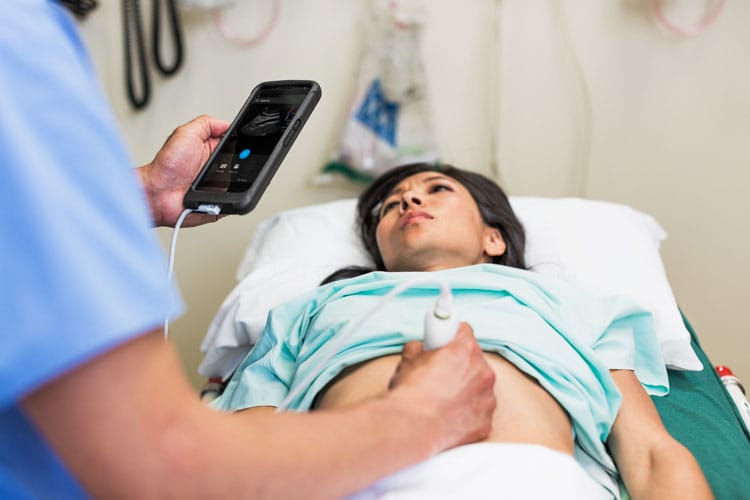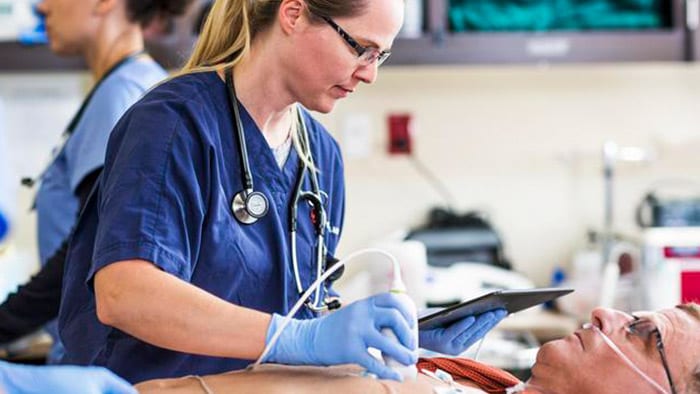Bedside ultrasound in the ED
October 3, 2017
The demands placed on emergency departments beg for new solutions to help ED physicians make fast, confident decisions. Today, product innovations and technology advancements provide some solutions. One is integrating the real-time information captured by ultrasound with small, handheld devices that don’t take up precious space and are ready when needed.
The benefits of using bedside ultrasound, also known as point-of-care ultrasound (POC US), have been well-documented over the last ten years. But studies show that more than half of ED doctors still don’t use it.1 Why? The Western Journal of Emergency Medicine points to three main barriers to the adoption of bedside ultrasound in the ED—and what can be done to overcome them.1
But first, let’s review the benefits. According to the American College of Emergency Physicians, POC US gives ED doctors access to real-time clinical information so that they can triage and diagnose patients faster.2 Time is always a precious resource in the ED, and it’s even more precious when a patient is coding or the ED is hit with a flood of patients who all require immediate attention. The speed and accuracy of bedside ultrasound in triage and diagnosis is why virtually all disaster preparedness plans recommend it as the first course of action.3 POC US also allows for faster patient throughput: when doctors can diagnose and care for them more quickly, patients spend less time waiting. And the reduction in wait times for patients can be significant. For instance, according to the Annals of Emergency Medicine, using bedside ultrasound in the ED to diagnose intrauterine pregnancies was almost three times faster than using formal radiology ultrasound and an ob-gyn consult, turning 170-minute visits into hour-long visits to the ED.4Benefits of point-of-care ultrasound

Finally, consider a situation where invasive procedures need to be performed. ED doctors can use bedside ultrasound for guidance rather than using blind landmark techniques. This technique leads to better healthcare outcomes with fewer complications, according to the Agency for Healthcare Research and Quality.5 As a result of getting faster, better care in the ED, patient satisfaction increases. A second study in the Annals of Emergency Medicine found that when patients were given bedside ultrasound, they perceived their physicians as more competent and had more confidence in their diagnoses.6,7 In other words, patients came to trust their doctors more, strengthening their relationships into the future. Given the benefits of bedside ultrasound, the fact that only 47 percent of doctors reported using POC US might come as a surprise. Yet those were the findings of a study in the Western Journal of Emergency Medicine published last year.1 The study’s authors identified three main barriers to the use of bedside ultrasound:Barriers to adopting point-of-care ultrasound
Notably, of the ED doctors who said that they weren’t using POC US because of limited need, the authors predicted that many would change their opinions if they were given more education about the benefits of bedside ultrasound. But because of limited training on POC US—a problem, in part, because many practicing ED doctors were trained prior to the widespread use of bedside ultrasound—the doctors didn’t know enough about POC US or its benefits for patient care to see a need for it. Given the triple barriers of training, cost, and perceived limited need for bedside ultrasound, what can be done to increase its use, especially in the ED where it offers significant benefits to patient care? Ultimately, the study’s authors recommended leveraging “recent educational and technical advancements” to get POC US into the hands of more doctors. Bottom line: To increase the use of bedside ultrasound, doctors need ultrasound devices that are affordable, portable, and easy to learn. They need C-Suite stakeholders to back them up by recommending and approving the purchase of these devices. And they need the radiology department to help train them on ultrasound.8 At the end of the day, increasing the use of bedside ultrasound in the ED will be a tandem effort, but by combining increased training with better ultrasound devices, widespread use of POC US can become a reality.

New solutions Pricing models, too, are changing. While traditional ultrasound equipment required large, up-front investments, options now offer subscription-based plans as well as outright purchase. As a result, devices like Philips Lumify are more affordable. Combined, these new approaches to ultrasound are making it possible for doctors to provide even better care to their patients, when they need it most.
New ultramobile ultrasound technologies, such as Philips Lumify, offer one way to overcome the barriers facing adoption of bedside ultrasound. Exemplary of a new approach to medical technology, which aims to bring the ease of use typically associated with consumer products to the realm of medicine, Philips Lumify combines transducers with Android-based smart devices to create an ultrasound system that doctors can easily carry with them. The device is simple and intuitive to use, so that in the most frenetic moments of the ED, doctors don’t have to struggle to diagnose and triage their patients.
Philips Lumify References:
Learn more about Philips Lumify and how Lumify has overcome the barriers to adoption.
Related stories
-

Education across borders with Lumify Reacts
Education across borders with Lumify Reacts
-

Point-of-Care ultrasound clinical education resources
At Philips, we believe clinical education is a key part of streamlining medical management in the critical care setting.
-

Enhancing patient care with Lumify case study
Dr. Tierney used Lumify to performed point-of-care pulmonary and cardiac ultrasound. The lung examination demonstrated findings consistent with bilateral pulmonary edema and pleural effusions without pneumothorax. Read the case study
-
